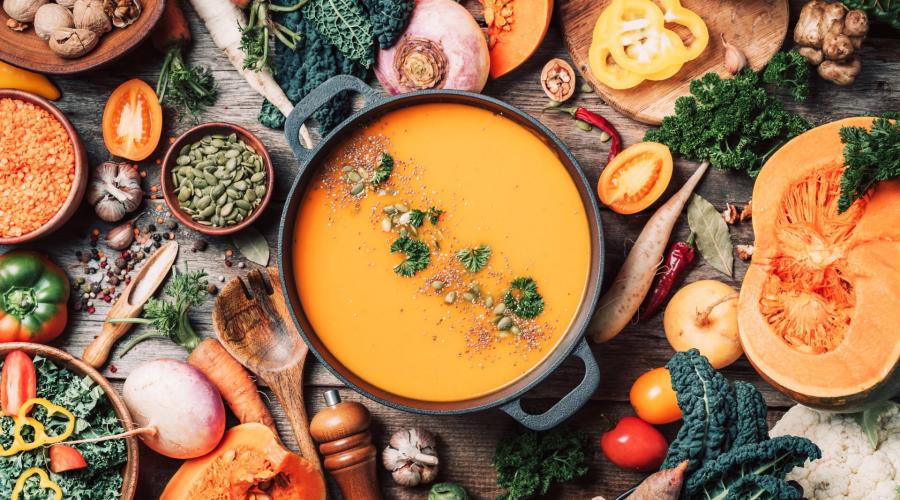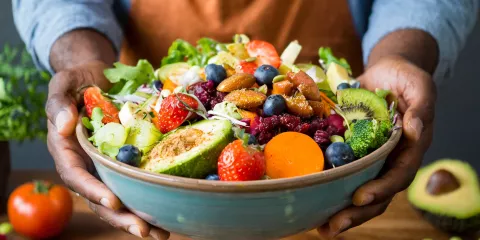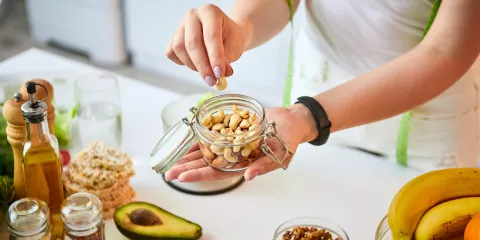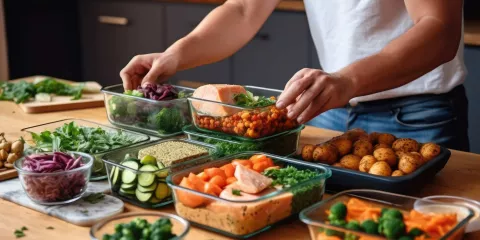
The harvest is coming in, and your local grocery store or farmer’s market may be brimming with seasonal fall produce!
In this post, we’ll talk about how to eat healthy during the fall. We’ll discuss what great, nutritious fall foods are available and give you some tips to improve your diet quality during this bountiful season.
Fall Healthy Eating
Fall is one of the best times to eat locally and seasonally. To find the best produce right now, you need to know what foods are in season in the fall. Seasonal eating helps support local farmers, keeps costs at bay and gives you better tasting, more nutritious produce.
In the US, the following are at their peak in September, October and/or November:1
| Fall Fruits | Fall Vegetables |
|---|---|
| Apples | Beets |
| Banana | Bell peppers |
| Cranberries | Broccoli |
| Grapes | Brussels sprouts |
| Kiwi | Cabbage |
| Lemons | Carrots |
| Limes | Cauliflower |
| Mangoes | Celery |
| Pears | Collard greens |
| Pineapple | Green beans |
| Pumpkin | Kale |
| Raspberries | Lettuce |
| Mushrooms | |
| Onion | |
| Parsnips | |
| Peas | |
| Potatoes | |
| Radishes | |
| Rutabaga | |
| Spinach | |
| Sweet potatoes | |
| Swiss chard | |
| Turnips | |
| Winter squash | |
| Yams |
To see what foods are in season in your location, check out this seasonal food guide.
4 Tips to Eat Healthier This Season
Looking forward to warm, cozy meals and the start of the holiday season? This time of year is all about pumpkin spice lattes, apple cider donuts, Oktoberfest and Thanksgiving dinner, but it’s important to balance those treats with healthy choices.
Let’s help make healthy eating a little easier with our top fall nutrition tips. Whether you want to improve diet quality or simply eat more seasonal produce, these tips can help you reach your health goals.
Related: How To Stay Active Over the Holidays
#1 - Warm Up Your Salads
When it’s frosty outside, you probably don’t want a cold salad with raw veggies. For some people, a cold salad isn’t satisfying or doesn’t sit well with them. This may be because some produce such as apples, mushrooms and onions contain FODMAPS. FODMAPS are specific carbohydrates that can cause symptoms like bloating, gas and cramping.2
You can still get tons of great nutrition in warm, cooked salads. And if you’re bothered by high FODMAP foods, add low FODMAP foods such as bell peppers, carrots, potatoes, pumpkin seeds and walnuts.3
#2 - Hydrate
Staying hydrated isn’t just for the hot summer months! In fact, as the average temperature drops, it may be harder for some people to stay hydrated since they’re not battling the heat.
Related: 5 Ways To Drink More Water
However, between passing cold fronts and low indoor humidity, things can get pretty dry! To prevent or remedy dry mouth, dry skin and general dehydration, consider adding the following to your autumn diet plan:
- Water: Fluid recommendations vary based on your individual needs. However, water recommendations from health experts are generally 12-15 cups per day for men and 9-11.5 cups per day for non-pregnant, non-breastfeeding women.4-6
- Soups: Aim for low-sodium broths when possible. Sodium and salt can make you thirsty and promote water retention.
- Decaffeinated or herbal teas: If you find yourself drinking less cold water during colder months, find a warm, non-caffeinated beverage to sip on.
- 100% fruit juice: A great way to drink down some nutrients like vitamin C. It’s best to limit the amount of juice you drink because it’s high in sugar, so consider cutting it with water.
- Juicy fruits: Snack on water-rich apples, cranberries, grapes, kiwi, mangoes, pears and pineapples.
- Vegetables with high water content: Incorporate water-rich vegetables like bell peppers, celery, Swiss chard, cabbage, broccoli and cauliflower. For hydration purposes, avoid air-frying or roasting, which can dry them out. Consider steaming or boiling instead.
- Electrolyte drinks: Electrolytes such as potassium, sodium, chloride and magnesium are especially important for hydration and proper body functioning. A few sips of an electrolyte drink can help you quickly rehydrate.
#3 - Create Simple Twists on Fall Favorites
You might wait all year for pumpkin spice season, but you can still enjoy iconic flavors while fueling your body with great nutrition. Here are some ideas to make fall comfort foods a little healthier:
- (Healthy) pumpkin pie spread: Take plain, canned pureed pumpkin, and load it up with tons of pumpkin pie spice. Use this healthy spread in yogurt, oatmeal, on toast or as a dip.
- (Winter squash) carbonara: Spiralize winter squash. Replacing noodles with squash helps you pack in extra nutrition with less calories overall. And, when you’re craving carbonara flavors, pile classic carbonara ingredients onto your squash. For a leaner meal, replace pork with turkey or mushrooms.
- Hearty (veggie) chili: Prioritize vegetables in your chili. You’ll find so many delicious fall vegetables that pair well with the mouth-watering flavors of chili. Go completely vegetarian with beans and lentils, or add lean ground turkey or chicken to replace beef.
Get The Meal Plan: 12 Months Of Healthy Eating: Healthy Comfort Foods
#4 - Focus on Key Seasonal Nutrients
It’s essential to get a variety of nutrients all year long, but you may want to pay special attention to certain ones in the fall. Try to include these key nutrients in your fall diet:
- Calcium: Calcium is important for bone health all year round, but in the fall, ice on sidewalks, steps, streets and porches may start to appear. If you do fall, you risk injury or bone fracture. Equip yourself with adequate calcium each day from dairy (preferably lowfat or nonfat), winter squash, soy, fortified OJ, salmon, sardines, almonds and leafy greens (kale, spinach and collard greens).7
- Vitamin D: A vitamin we get from sunlight and/or certain foods. As the days get shorter and we spend more time indoors (or bundled up outdoors), we may need to pay more attention to this vitamin. Found in salmon, egg yolk, fortified cereals and fortified milk.8
- Immunity nutrients (zinc, iron and vitamin C):9 To support healthy immune function as the cold weather arrives, focus on these key nutrients. For zinc, choose foods like fortified cereals, sardines, pumpkin seeds or lean beef.10 For iron, choose foods like eggs, lean poultry, beans, leafy greens or fortified cereals.11 For vitamin C, choose foods like citrus, bell peppers, potatoes or cruciferous vegetables.12
- Probiotics and prebiotics: Both play a role in maintaining a healthy gut, which has a close relationship with immunity. Prebiotics (or the “food” for probiotics) are found in cabbage, onions and bananas. Probiotics are found in kefir, yogurts with active cultures and fermented foods.9
Read More: Can Supplements Benefit Your Healthy Diet?
Even though it is best to get nutrients from real food, talk to your provider about your need for multivitamins and other nutritional supplementation.
References
1 US Department of Agriculture. Seasonal produce guide. SNAP Education Connection Website. Accessed January 30, 2023.
2 Dietitians in Medical Nutrition Therapy. Nutrition therapy: The low FODMAP diet. AND Website. Accessed January 30, 2023.
3 Cleveland Clinic. Low FODMAP diet. Cleveland Clinic Website. Published February 24, 2022. Accessed March 14, 2023.
4 Gordon B, Klemm S. How much water do you need? Eat Right Website. Published June 23, 2022. Accessed February 14, 2023.
5 Fried School of Nutrition Science and Policy. Hydration: What to know for hot weather. Tufts Now Website. Published June 30, 2022. Accessed February 14, 2023.
6 Kleiner SM. Water. J Acad Nutr Diet. 1999;99(2). https://doi.org/10.1016/S0002-8223(99)00048-6
7 Harvard School of Public Health. Calcium. Harvard Health Website. Accessed March 14, 2023.
8 Ellis E. What is vitamin D? AND Website. Published February 16, 2022. Accessed November 15, 2022.
9 Harvard School of Public Health. Nutrition and immunity. Harvard Health Website. Accessed March 14, 2023.
10 Office of Dietary Supplements. Zinc. National Institutes of Health (NIH) Website. Published March 2, 2018. Updated September 28, 2022. Accessed March 14, 2023.
11 Cleveland Clinic. 52 foods high in iron. Cleveland Clinic Website. Published November 4, 2020. Accessed March 14, 2023.
12 Harvard School of Public Health. Vitamin C. Harvard Health Website. Accessed March 14, 2023.












